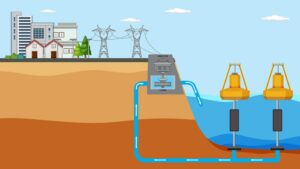Water Pumping Energy Storage

Water pumping is a simple and effective way to store energy. It uses excess energy to pump water to a higher elevation, which can then be released to generate electricity when needed. This technology has been used for many years to store energy from renewable sources such as wind and solar power, as well as from conventional sources such as coal and nuclear power.
The basic concept of water pumping energy storage is simple: water is pumped from a lower reservoir to a higher reservoir when electricity is cheap and abundant. When the demand for electricity increases, the water is released from the upper reservoir to drive turbines and generate electricity. The process is simple, efficient, and highly effective.
One of the most significant advantages of water-pumping energy storage is its scalability. It can store large amounts of energy for various applications, from grid-scale energy storage to small-scale systems for homes and businesses. Water-pumping energy storage can also be integrated with other technologies, such as batteries and flywheels, to provide a more comprehensive and reliable energy storage solution.
Another advantage of water-pumping energy storage is its high efficiency. Unlike other energy storage technologies, such as batteries, which can lose energy over time due to leakage, water-pumping energy storage can maintain high efficiency for decades. This makes it an ideal solution for long-term energy storage, especially for highly reliable and consistent applications.
Water-pumping energy storage can also reduce carbon emissions and promote using renewable energy sources. By storing excess energy generated from wind and solar power, water pumping energy storage can help reduce reliance on fossil fuels and promote clean, renewable energy sources.
Despite its many advantages, water-pumping energy storage does have some limitations. One of the biggest challenges is finding suitable sites for constructing reservoirs and hydroelectric power plants. These sites must be located in areas with adequate water resources and topography, which can be challenging in some regions.
Another challenge is the cost of construction and maintenance. Water-pumping energy storage systems can be expensive to build and maintain, especially for large-scale applications. However, the long-term savings achieved by using renewable energy sources and reducing reliance on fossil fuels can offset the cost.
In conclusion, water-pumping energy storage is a simple, efficient, and effective way to store energy from renewable and conventional sources. It offers many advantages, including scalability, high efficiency, reducing carbon emissions, and promoting renewable energy sources. While some challenges are associated with the technology, these can be overcome with careful planning and investment. As the world transitions to a more sustainable energy future, water-pumping energy storage will likely play an increasingly important role in meeting our energy needs.